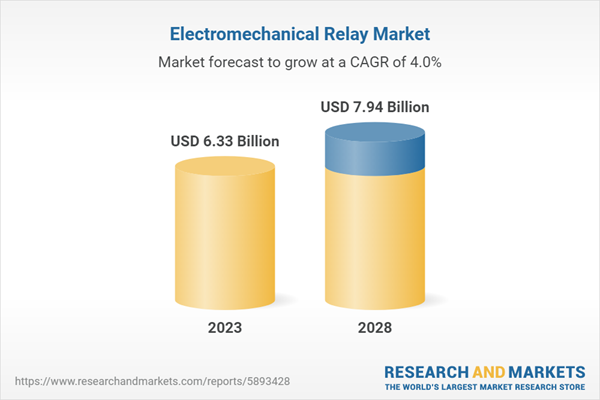Speak directly to the analyst to clarify any post sales queries you may have.
10% Free customizationThis report comes with 10% free customization, enabling you to add data that meets your specific business needs.
An electromechanical relay is a type of relay that operates by creating a magnetic field when a control signal is applied to it. It is referred to as electromechanical since the output circuit comprises movable contacts that can be moved in response to an electrical signal. There are input terminals in the input section where a small control signal is to be applied. When a control input signal is applied to the input terminals, an electromagnetic coil in the control section is activated. The output section is made up of a movable armature and mechanical contacts that are both movable and stationary, and the movement of the armature establishes or breaks the electrical circuit.
Growing Number of Renewable Energy Projects & Technological Advancements in Electricity Generation Process
Additionally, the driving demand for high-capacity electromechanical relays is due to the growing number of renewable energy projects, which is helping the global electromechanical relay (EMR) market development. As the demand for coal and natural gas continues to rise because of expanding industrialization and commercialization, people are using equipment that consumes increasing amounts of electrical energy. Additionally, a growing number of individuals worldwide are worried about the environment and wanted to reduce the carbon footprint left behind. These two factors are essential drivers of the market growth for renewable energy, due to this rising concern of clean and green energy the demand of electromechanical relay has been gaining traction.The demand for electromechanical relays is driven by the expansion of energy infrastructure, including power generating, transmission, and distribution systems. These relays ensure dependable and effective energy distribution by being utilized in switchgear, protection systems, and control circuits. Additionally, growing number of renewable projects in worldwide such as, in November 2022, in Netherlands' Oostvoornse lake, Solaris deployed its Protevs test project. A total installed peak capacity of 50.7 kW-p was supplied by 139 floating PV solar panel modules which formed part of the project. When compared to conventional floating panels, the solar panels with the sun-tracking function produce 40% more energy since they spin in the direction of greatest sunlight concentration. Solaris Float wants to deploy seven Protev islands around Europe to produce 2 GW of power yearly to take full advantage of this innovation.
Also, to address this issue of electricity generation and insufficient sunlight to plants because of solar PV, the EU granted the REGACE Consortium a grant of USD 5.71 Million earlier in 2023. Due to this initiative, which is being developed by the Israeli business Trisolar, aims to come up with creative solutions for greenhouse growers to embrace renewable energy without endangering the life of their plants. The technique also improves the effectiveness of solar PV panels placed on greenhouses. In a way, it creates a symbiotic relationship between plants and solar panels. The panels aid in regulating the quantity of sunlight that reaches the plants so that they can take in a sufficient quantity of light. The panels create 10% more power than standard solar PV panels in exchange for using extra sunshine. As more people adopt this technology, the need for electromechanical relays used in renewable energy ways is rapidly increasing. These technologies aid in the process of generating electricity from renewable energy sources.
Growing Industrial Automation Sector is Propelling the Market Growth
The electromechanical relay market is significantly being driven by the rising usage of automation in sectors like industrial, automotive, and electronics. Control panels, motor control circuits, and safety systems in automated processes all often involve electromechanical relays. As industrial automation is expanding quicky, the demand of electromechanical relay is also increasing worldwide, since large amount of electromechanical relay is used in automation industry. For instance, in 2020, the size of the global industrial automation market was around 175 billion dollars. Up to 2025, the market is anticipated to expand at a compound annual growth rate (CAGR) of around 9%. The size of the worldwide industrial automation market is anticipated to be over 265 billion dollars by 2025.Additionally, compared to electronic equivalents, electromechanical relays are renowned for their dependability and extended lifespan. The high demand for electromechanical relays is influenced by sectors including electricity utilities, transportation, and industrial machines that need reliable and long-lasting switching solutions.
Technological Advancements in Electromechanical Relay
The market is driven by technological developments in electromechanical relay design, including enhanced contact materials, decreased power consumption, and increasing miniaturization. These developments provide improved performance, increased efficiency, and fresh application possibilities. Electromechanical relays are now smaller because of technological developments, making it possible to utilize them in compact devices and other applications. Since, miniature relays are perfect for mobile electronics, automotive systems, and Internet of Things (IoT) devices as they deliver outstanding reliability while taking up minimal physical space. Due to this advancement, the switching speed of electromechanical relays has increased due to developments in materials and relay design. Relays are useful for high-speed switching applications like telecommunications and automation systems since faster switching rates allow them to react rapidly to control signals. Due to all the above-mentioned technological advancements, the global electromechanical relay market is anticipated to grow in the forecast period.High Maintenance Costs Hindering the Market Growth
Traditional electromechanical relays have been replaced with solid-state relays (SSRs), which employ semiconductors in place of mechanical contacts. SSRs are advantageous since they switch more quickly, last longer, and operate quietly. They are particularly well suited to high switching frequency applications like industrial control systems and electrical devices. Electromechanical relays face competition from electronic relays like solid-state relays (SSRs) and semiconductor-based switches. In certain situations, electronic relays have advantages including improved switching reliability, smaller sizes, and quicker switching rates. In certain industries, the need for electromechanical relays might be constrained by the presence of electronic substitutes. Electromechanical relays have moving components like contacts and springs that deteriorate with time. This requires routine maintenance and component replacement, which increases costs and generates downtime for systems using electromechanical relays. Thus, other solid-state or low-maintenance technologies could be preferred by some businesses. These factors are restraining the market growth in the forecast period.Market Segmentation
The global electromechanical relay market is divided into type, application, end user, and region. Based on type, the market is segmented into general purpose relay, power relay, contactor, time-delay relay, and others. Based on application, the market is segmented into factory automation, temperature controllers, motor controls, and others. Based on end user industry, the market is segmented into aerospace and defense, communication and technology, HVAC, automotive, consumer electronics, and others. Based on region, the market is divided into North America, Asia-Pacific, Europe, South America, and Middle East & Africa.Market Players
Major market players in the global electromechanical relay market are Ashida Electronics Pvt. Ltd, DARE Electronics, Inc, Leone Systems, TE Connectivity Ltd, Ashida Electronics Pvt. Ltd, Control &Switchgear Electric Limited, Eaton Corporation, Hitachi Energy Ltd, ABB Ltd, Siemens AG, General Electric, GE Digital Energy, ZETTLER Group, and Mors Smitt BV.Report Scope:
In this report, the global electromechanical relay market has been segmented into following categories, in addition to the industry trends which have also been detailed below:Electromechanical Relay Market, By Type:
- General Purpose Relay
- Power Relay
- Contactor
- Time-Delay Relay
- Others
Electromechanical Relay Market, By Application:
- Factory Automation
- Temperature Controllers
- Motor Controls
- Others
Electromechanical Relay Market, By End User Industry:
- Aerospace and Defense
- Communication and Technology
- HVAC
- Automotive
- Consumer Electronics
- Others
Electromechanical Relay Market, By Region:
- North America
- United States
- Canada
- Mexico
- Asia-Pacific
- China
- India
- Japan
- South Korea
- Indonesia
- Europe
- Germany
- United Kingdom
- France
- Russia
- Spain
- South America
- Brazil
- Argentina
- Middle East & Africa
- Saudi Arabia
- South Africa
- Egypt
- UAE
- Israel
Competitive Landscape
Company Profiles: Detailed analysis of the major companies present in the global electromechanical relay market.Available Customizations:
Global electromechanical relay market report with the given market data, the publisher offers customizations according to a company's specific needs.This product will be delivered within 1-3 business days.
Table of Contents
Companies Mentioned
- Ashida Electronics Pvt. Ltd
- DARE Electronics, Inc.
- Leone Systems
- TE Connectivity Ltd
- Ashida Electronics Pvt. Ltd
- Control &Switchgear Electric Limited.
- Eaton Corporation
- Hitachi Energy Ltd
- ABB Ltd
- Siemens AG
- General Electric
- GE Digital Energy
- ZETTLER Group
- Mors Smitt BV
Table Information
| Report Attribute | Details |
|---|---|
| No. of Pages | 178 |
| Published | October 2023 |
| Forecast Period | 2023 - 2028 |
| Estimated Market Value ( USD | $ 6.33 Billion |
| Forecasted Market Value ( USD | $ 7.94 Billion |
| Compound Annual Growth Rate | 3.9% |
| Regions Covered | Global |
| No. of Companies Mentioned | 14 |









